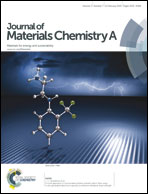Ionothermal synthesis of black Ti3+-doped single-crystal TiO2 as an active photocatalyst for pollutant degradation and H2 generation†
Abstract
A black Ti3+-doped single-crystal TiO2 (Ti3+/TiO2) was one-pot synthesized by treating Ti metal in an ionic liquid containing LiAc and HAc under mild ionothermal conditions. The ionic liquid (1-methyl-imidazolium tetrafluoroborate) supplied an environment enriched with fluoride ions for dissolving titanium foil under ionothermal conditions, followed by reducing protons in acetic acid to form Ti3+ ions, leading to Ti3+-doped single-crystal TiO2 as a black powder. EPR and XPS results indicated the high concentrations of both Ti3+-dopants and oxygen vacancies. The Ti3+ incorporated into the TiO2 lattice could narrow the energy band gap of TiO2via forming intermediate energy levels, leading to a visible photocatalyst. Meanwhile, the oxygen vacancies could inhibit the photoelectron–hole recombination. As expected, such a black Ti3+/TiO2 exhibited high activity in the photocatalytic degradation of organic pollutants and water splitting for H2 production under irradiation with visible light and/or simulated solar light.


 Please wait while we load your content...
Please wait while we load your content...